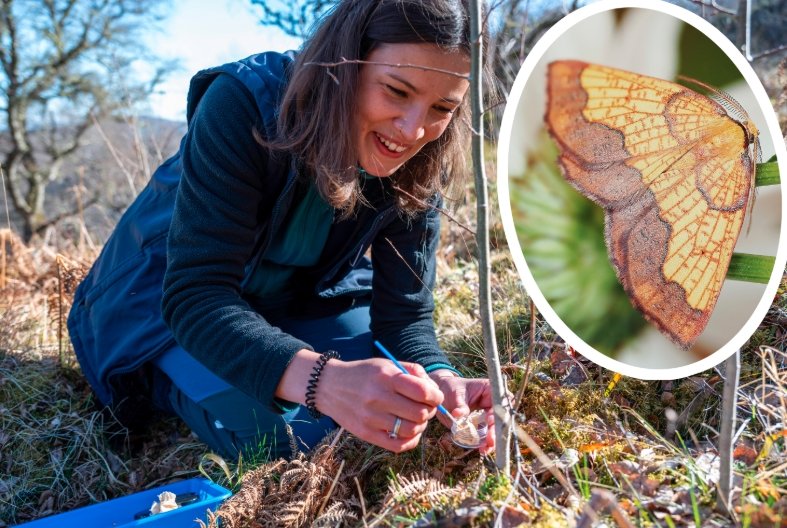A new study from the University of Stirling shows that efforts to restore ancient Caledonian forests in the Scottish Highlands are greatly increasing moth numbers and variety. Led by PhD student Patrick Cook for Butterfly Conservation, the research highlights how deer control on the Mar Lodge Estate has helped woodlands regrow and support more wildlife in just a few decades.
Key Findings from the Moth Study
Researchers found clear differences in moth populations across different land types on the Mar Lodge Estate in the Cairngorms. They recorded moths over 12 nights in summer 2023 using traps in mature ancient forests, young regenerating woodlands, and open moorlands.
The data revealed higher moth counts and more species in wooded areas than in open spaces with more deer. Mature woodlands topped the list with 1,502 moths from 85 species, while young woods had 820 moths from 85 species. Open moorland lagged behind with only 654 moths from 55 species.
This boost in young woods, which can form in 10 to 20 years, proves quick wins are possible with the right management. The study, published in the Journal of Ecological Solutions and Evidence, stresses that a mix of habitats works best for overall wildlife health.
One interesting note came from species like the Ingrailed Clay moth, which thrived more in woods. Even some moths thought to prefer open land showed benefits near trees, showing how restoration can shift what we know about animal needs.

How Deer Control Drives Woodland Regrowth
The National Trust for Scotland has spent 30 years on the 29,000-hectare Mar Lodge Estate fighting back against lost forests. Historic logging, deer grazing, sheep pressure, burning, and climate shifts have wiped out two-thirds of Scotland’s ancient woods since 1750.
Today, native pinewoods cover less than 18,000 hectares in 84 scattered patches, with 23 percent at critical risk. Red deer and sheep eat young Scots pine saplings, stopping natural spread without help.
Past fixes like fences worked for small spots but took too much time and effort. Now, experts use wide-area deer culling to lower numbers safely, letting seeds from old trees sprout freely. This method has added thousands of hectares of new woods around ancient sites on the estate.
Shaila Rao, conservation manager at Mar Lodge, noted that the results build trust in their work. She said a blend of old forests, new growth, and open land maximizes life in Scotland’s high areas.
Moths as Signs of a Healthy Environment
Moths play a big part in nature beyond their nighttime flights. They pollinate plants and feed birds, bats, and other creatures, making them key to balanced ecosystems.
In Scotland, thriving moths signal that broader wildlife is doing well. The study shows how forest work helps not just moths but the whole food web. For example, more moths mean more food for species like pine martens, which just returned to areas like Exmoor in 2025 as part of recovery projects.
Experts like Patrick Cook call moths great indicators. He explained that their success points to healthy surroundings where pollinators and prey abound. This ties into global fights against deforestation, a top worry for ecologists everywhere.
Recent finds, such as the tadpole shrimp returning to a Scottish reserve after 75 years, show nature can bounce back with support. Moths in restored woods follow this trend, offering hope amid insect declines seen worldwide.
Table: Moth Counts and Species by Habitat Type
| Habitat Type | Total Moths Recorded | Number of Species |
|---|---|---|
| Mature Woodland | 1,502 | 85 |
| Young Woodland | 820 | 85 |
| Open Moorland | 654 | 55 |
This table sums up the 2023 survey results, highlighting the edge wooded areas have in supporting moth life.
Wider Impacts on Scottish Nature Recovery
The Mar Lodge success points to bigger changes across Scotland. Groups like Trees for Life aim to double pinewood areas by 2055 through natural regrowth. In 2025, Forestry and Land Scotland restored a record 1,226 hectares of rainforest zones, up from 930 the year before.
Future Woodlands Scotland added 34 hectares of ancient pine this year, one of the rarest habitats left. Efforts also include removing non-native trees and cutting herbivore impacts to rebuild full ecosystems.
These steps link to UN goals for sustainable land use. They fight climate change by storing carbon in growing trees while boosting local species. A 2024 Guardian report on hunting lost pinewoods shows public interest in these hunts, with less than 2 percent of original growth left.
- Benefits of mosaic habitats include support for 300-plus insect types, like in nearby orchards where flower strips cut pests by 61 percent.
- Quick regrowth in 10 years helps fight urgent threats like grazing pressure.
- Ties to other wins, such as pine marten releases, show connected recovery efforts.
Future Steps for Forest and Moth Protection
As Scotland pushes rewilding, studies like this guide smarter land care. Deer management at scale could spread benefits fast, creating past-like landscapes with mixed woods and moors.
Experts urge balancing woods with open spaces, as some moths and plants need exposure. This approach could lift biodiversity across the Highlands, aiding pollinators and prey in a changing world.
Readers, share your thoughts on forest restoration in the comments below. What local efforts have you seen, and how can we all help boost nature? Your input matters in this ongoing story.


















